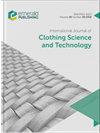研究织物的水汽保持性及其对座椅套的适用性
IF 1
4区 工程技术
Q3 MATERIALS SCIENCE, TEXTILES
International Journal of Clothing Science and Technology
Pub Date : 2023-06-08
DOI:10.1108/ijcst-11-2022-0161
引用次数: 0
摘要
目的水蒸气被困在人和衣服之间的边界层会产生不适和其他不愉快的感觉。当外部蒸汽屏障或不可渗透层阻止水蒸气离开衣服时,这些心理物理状态会进一步加剧。一种可能会出现问题的情况是在办公室工作场所,以及员工每天使用数小时的座位。本研究旨在评估用于座套的不同织物对水蒸气保持性的影响。设计/方法/方法作者的方法确定了座椅上50 kg沙袋接触表面湿度的行为,以模拟座椅材料因就座者的重量而产生的变形。因此,得出了座椅表面加湿后相对湿度(RH)的最大增加量(ΔRH max)、达到湿度最大值所需的时间(t-max)和湿度开始下降后的时间常数(TC)。结果在测试的三种不同座套中,羊毛的ΔRH max为7.3-8.8%,而聚氯乙烯(PVC)的ΔRH最大值为27.0-29.0%,这表明羊毛的吸湿性和透光性更强。丙烯酸覆盖物的TC为224–384分钟,而PVC的TC为483–558分钟,这表明丙烯酸具有快速干燥的特点。原始性/值ΔRH max、t-max和TC均与实际人类参与者大腿后皮肤表面的RH显著相关。本文章由计算机程序翻译,如有差异,请以英文原文为准。
Investigating water vapor retention of fabrics and their suitability for seat coverings
PurposeWater vapor trapped in the boundary layer between a person and the clothing creates discomfort and other unpleasant sensations. When that water vapor is prevented from leaving the clothing by external vapor barriers or impermeable layers, those psychophysical states are further exacerbated. One situation where that can be problematic is in office workplaces, and the seats that workers use for many hours every day. This study aims to evaluate the impact of different fabrics that are used for seat cover on water vapor retention.Design/methodology/approachThe authors' method determines the behavior of contact surface humidity with a 50 kg sandbag on the seat to mimic the deformation of the seat materials due to the seated person's weight. Thus, the maximum increase in relative humidity (RH) after humidification of the seat surface (ΔRH-max), the time required to reach the maximum value of humidity (t-max) and the time constant (TC) after humidity starts to fall were derived.FindingsOf the three different seat covers tested, the ΔRH-max of the wool were 7.3–8.8%, compared to 27.0–29.0% of the polyvinyl chloride (PVC), indicating more moisture absorption and transmission of the wool. The TC of the acrylic cover was 224–384 min compared to the 483–558 min of the PVC, which indicated a quick drying out feature of the acrylic.Originality/valueThe ΔRH-max, t-max and TC were all significantly correlated with the RH at the back thigh skin surface of the actual human participants.
求助全文
通过发布文献求助,成功后即可免费获取论文全文。
去求助
来源期刊
CiteScore
2.40
自引率
8.30%
发文量
51
审稿时长
10 months
期刊介绍:
Addresses all aspects of the science and technology of clothing-objective measurement techniques, control of fibre and fabric, CAD systems, product testing, sewing, weaving and knitting, inspection systems, drape and finishing, etc. Academic and industrial research findings are published after a stringent review has taken place.

 求助内容:
求助内容: 应助结果提醒方式:
应助结果提醒方式:


